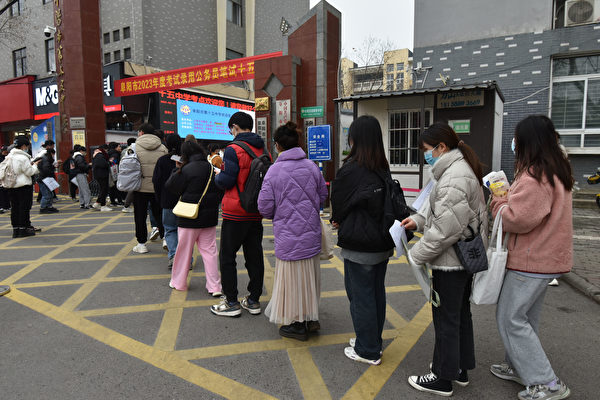China’s economy is struggling, with high unemployment rates, especially among young people. As a result, the concept of a stable job, known as the “iron rice bowl,” is gaining popularity. More and more individuals are opting to take the civil service exam, leading to intense competition in the public sector. Recently, the largest-scale civil service joint exam of 2025 concluded with over 5.3 million participants competing for 166,000 positions.
According to reports from mainland China, on March 15, a total of 24 provinces and cities (including the Xinjiang Production and Construction Corps) held the written exam for the 2025 civil service positions. The civil service exam consists of the national exam and provincial exams, with the joint exam falling under the latter.
Statistics provided by Huatu Education indicate that this year’s civil service joint exam saw an increase of over 8% in recruitment, with 23 provinces planning to recruit a total of 166,000 individuals, an increase of 12,867 from the previous year. The total number of applicants for provincial exams in these 23 provinces exceeded 5.3 million.
Based on historical data, it is estimated that the number of participants in the provincial exams may exceed 4 million this year. Several provinces have seen record-high numbers of applicants. For example, Henan had over 700,000 applicants, Guangdong is estimated to have around 700,000 applicants, and Shaanxi had nearly 350,000 applicants.
Looking at the recruitment plans of various provinces, this year’s trend includes an increased proportion of fresh graduates, a higher percentage of master’s and doctoral degree holders, and a focus on grassroots positions.
Zheng Wenzhao, the CEO of Huatu Education, analyzed that the expansion of recruitment in most provinces is a response to employment pressures. With the current severe employment situation, the increase in civil service recruitment can help alleviate some of the job market pressures.
Zheng predicts that this year’s average competition ratio for provincial exams may exceed 65:1, indicating that future competitions, whether at the provincial or national level, will become even more intense. In the current job market environment, more and more candidates are leaning towards stable positions, leading to intensified competition in civil service and corporate sector exams.
On March 17, data released by the National Bureau of Statistics of the Chinese Communist Party revealed that China’s national urban unemployment rate reached 5.4% in February, a 0.2% increase from the previous month and the highest in two years, with an average of 5.3% for January and February. Additionally, the urban unemployment rate in 31 major cities was 5.2% in February, the highest in six months.
However, official data from the Chinese Communist Party often downplays unfavorable conditions, and the actual figures may be even worse.
According to a report by Radio Free Asia on March 10, to cope with employment pressures, universities have even begun to falsify employment rates. Official records show that the employment rate of the graduating class of 2023 was 55.7%, but internal documents revealed that even in economic hubs like Shanghai, the actual employment rate for fresh graduates was less than 30%.
Retired professor Li Dun from Tsinghua University expressed concerns, stating that recent graduates from top universities like Tsinghua and Peking University have approached him with worries about their job prospects. The increasing number of unemployed individuals each year has made finding a job a significant challenge.
He pointed out that with the expansion of enrollment in Chinese universities, the potential crisis in the job market has long existed, only fully exposed when economic downturn hits.
Retired professor Ding Xueliang from the Hong Kong University of Science and Technology echoed similar sentiments.
A report from the prominent Chinese online recruitment platform “Zhaopin” indicated that the employment rate for Chinese university graduates in 2024 was 55.5%.
Recently, Ding Xueliang wrote an article in Hong Kong’s “Sing Tao Daily,” where based on estimates from experienced observers, he suggested that the actual employment rate of the previous year’s fresh graduates was likely within the range of 30% to 35%, not exceeding 40%, and certainly not reaching 56%. If the average employment rate is 30%, the total number of unemployed individuals would be around 28.055 million.
Ding Xueliang recently exchanged views with mainland Chinese university teachers. They indicated that even the worst-performing universities have employment rates below 30%, with only about 20% of graduates finding jobs. Counseling advisors were telling fresh graduates who couldn’t find jobs to fill in forms with “flexible employment” and to claim they were working in social media if questioned during surveys.

